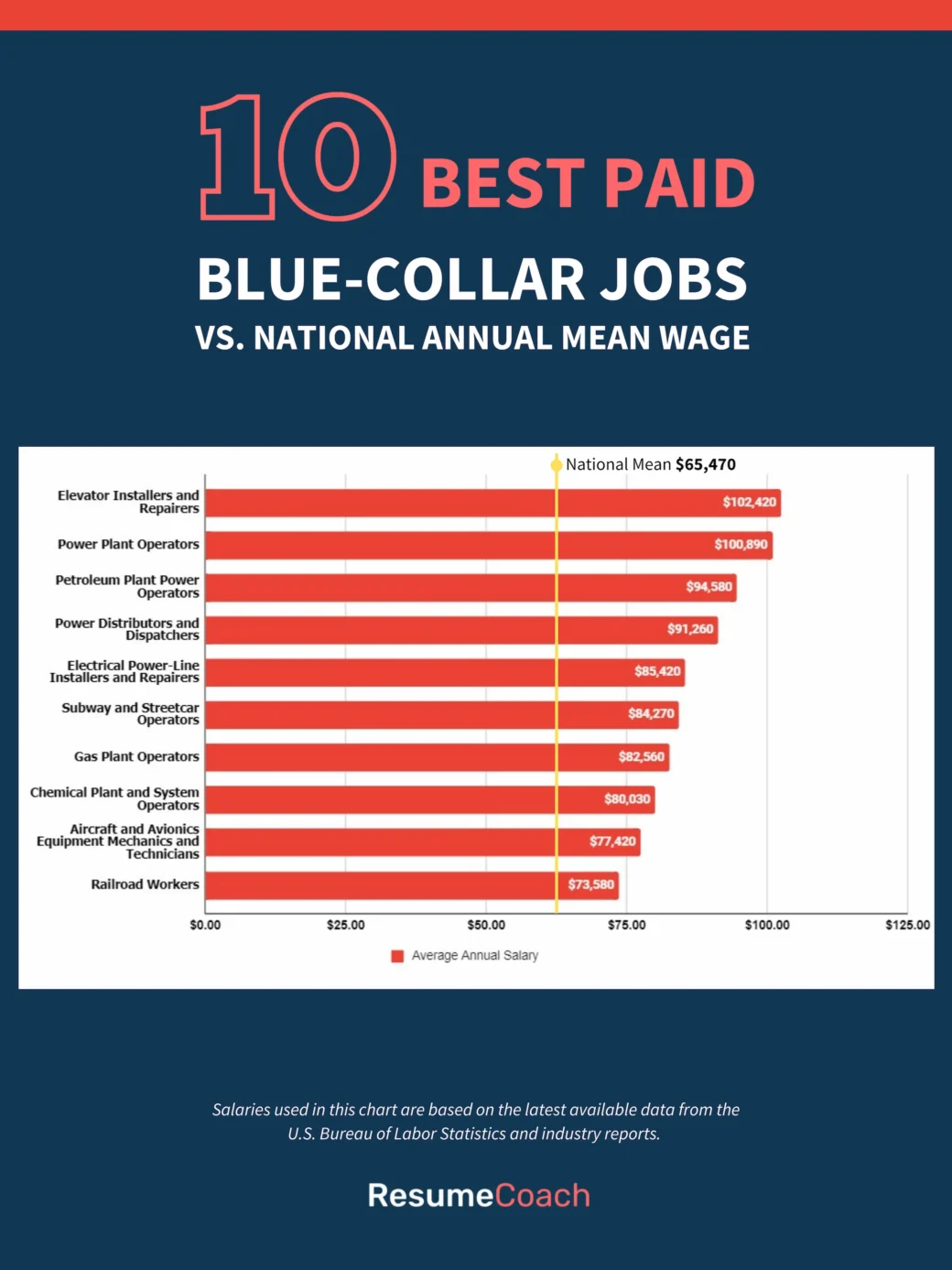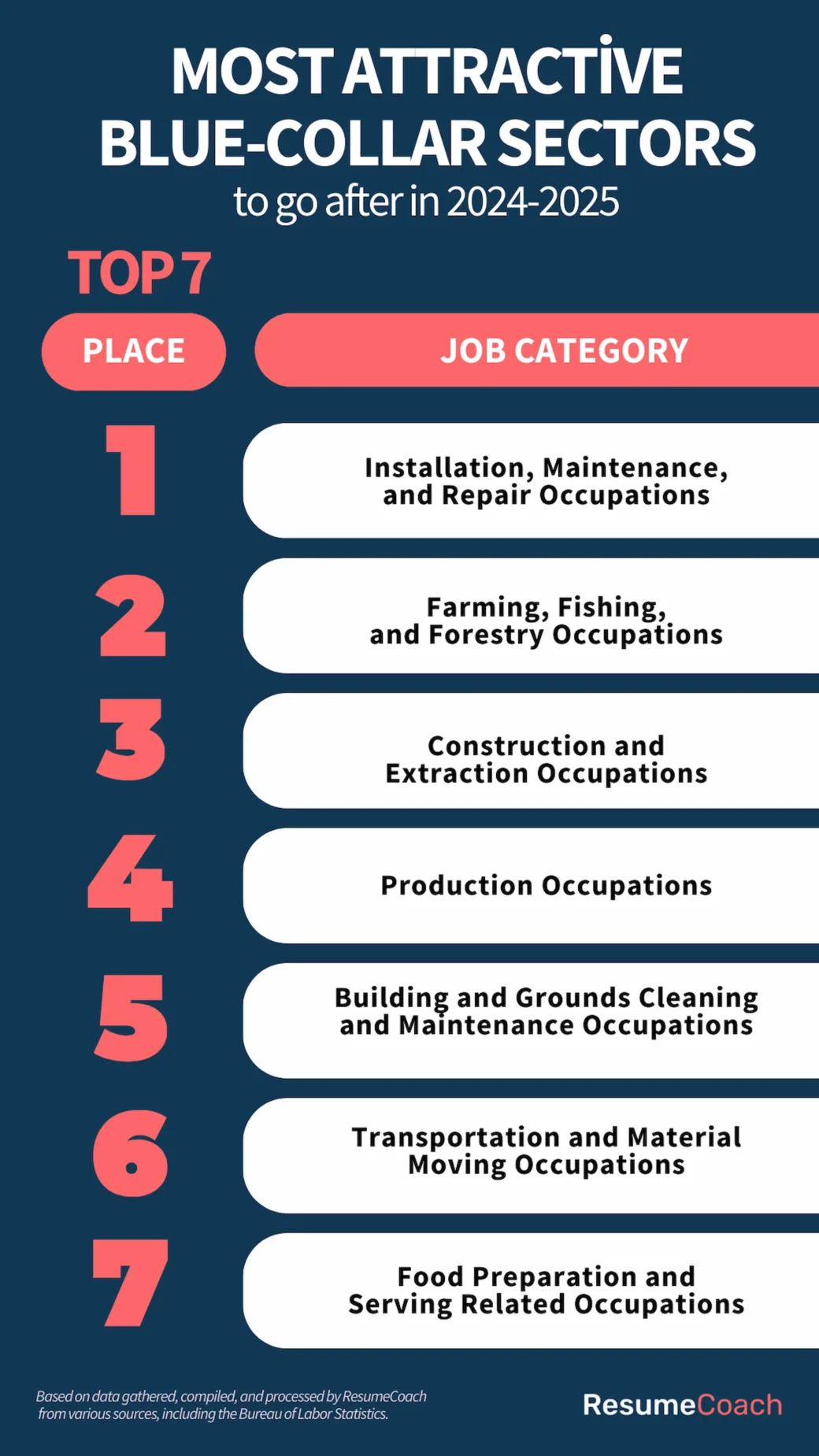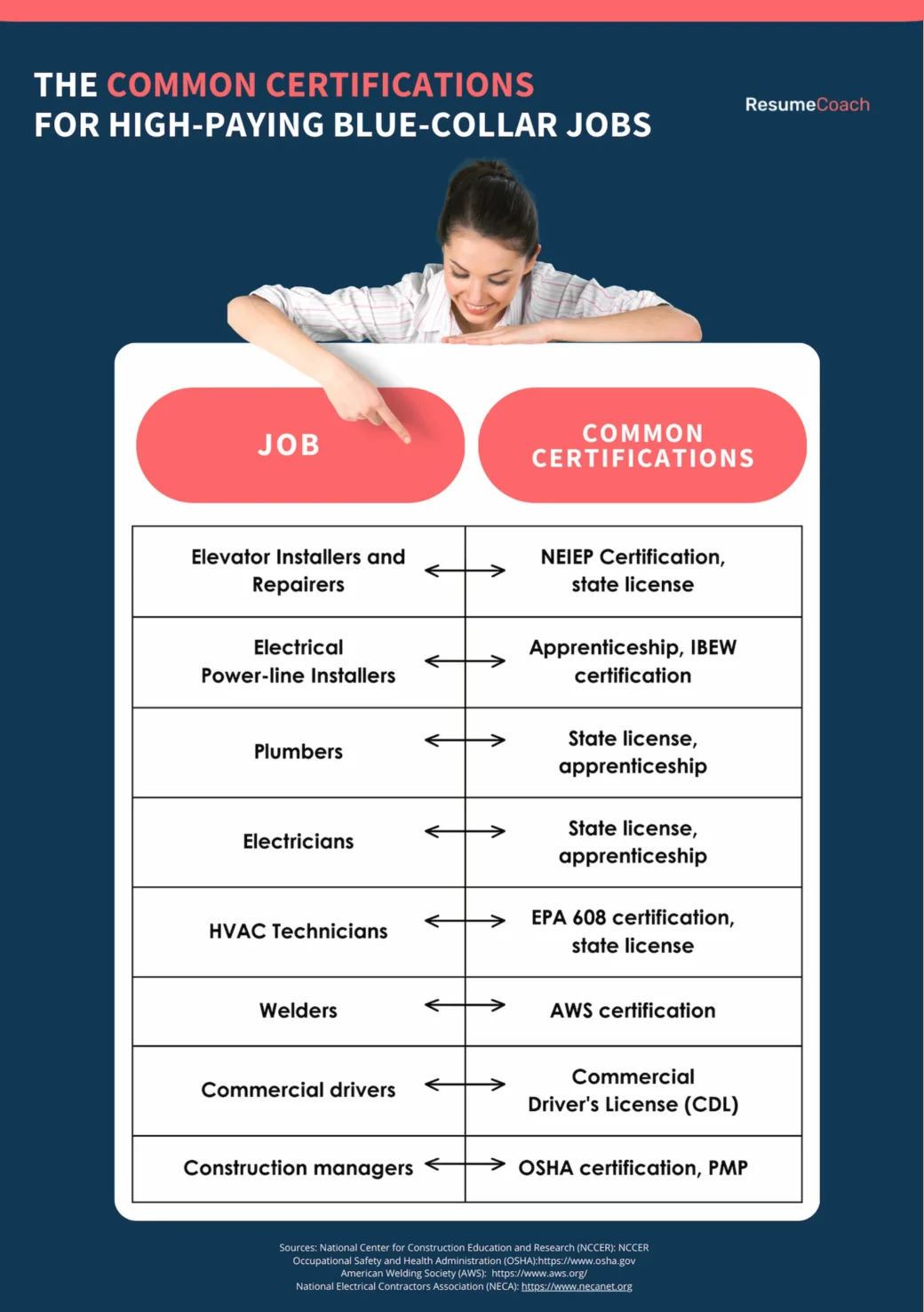Key Statistics
- 35% of top growing jobs are blue-collar roles, with over 1.7 million positions projected by 2032.1
- AI impact: Since May 20232, AI has been directly blamed for the loss of 800 jobs.
- Manufacturing growth: Expected to grow by 3% over the next decade.3
- Green collar boom: Jobs like wind turbine service technicians are set to grow by 45%.4
- Qualified workers wanted: 83% of blue-collar staff see inexperienced coworkers as a major safety concern.
- Union wage increases: Union worker salaries rose by 6.3% over the past year.5
- Key Statistics
- Filling Blue-Collar Job Openings in 2025
- Why Workers Favor Blue-Collar Roles
- Top 7 Blue-Collar Careers in 2025
- Two of the Fastest Growing Blue-Collar Careers Focus on Sustainability
- How To Get a Blue-Collar Job in the Age of AI
- Preparing for a Blue-Collar Career in the Future
- So, Is It Worth Being a Blue-collar Worker?
- Methodology
Blue-collar careers have often been thought of as the backbone of US industry. Many Americans are considering a return to stable blue-collar careers in a market facing layoffs due to several factors, such as AI growth, inflation, and overstaffing.6
In recent years, tech companies have been cutting jobs while making significant investments in generative AI, with 34,000 positions being cut at the beginning of 2024 alone, following 263,000 cuts in 2023, according to the Financial Times.7
Our team has conducted thorough research based on internal and external data to put together this report on job security for skilled workers and high-paying blue-collar jobs, with or without AI skills.
With this information and input from recruitment and tech sector experts, we were able to list the current best blue-collar jobs and those predicted to be most in demand in the future.
Filling Blue-Collar Job Openings in 2025
The blue-collar sector saw a significant number of hires across various sectors in 2024 but faced personnel issues. This trend appears to be continuing in 2025.
According to the Bureau of Labor Statistics (BLS), the construction and manufacturing sectors continue to hire significantly, driven by infrastructure projects and real estate redevelopment.
Revelio Labs reported in December 20248 that jobs in the construction sector were still growing at an accelerated rate despite inflation.
This boost is likely due to the expansion of infrastructure projects impulsed by the Inflation Reduction Act9, as well as higher demand for residential construction as millennials buy their first homes and remote work remains popular.
The construction industry reached a peak of 416,000 job openings in February 2024. However, filling these positions with experienced and skilled employees has been no easy task.10
As much as 83% of workers have cited inexperienced coworkers as a major safety concern due to the hiring surge. 11
Manufacturing, particularly in critical roles like welders and electricians, also faces high turnover and significant hiring needs, with an estimated 490,000 job openings in April 2024.12
Cybersecurity is another sector with jobs in high demand that many see as a blue-collar category, which requires qualified employees. 13
We spoke to Neil Khatod, Chief Information Security Officer for Hays Americas, about the importance of qualifications in the blue-collar job place. He was clear on the role they play, “It is the technician with the certifications (SEC+, CCNP, CISSP, CISM, CEH, etc.) who have the most relevance in this technical realm.”
The task here lies in investing in attracting, training, and retaining talent with relevant certifications in skilled roles, including blue-collar jobs that pay well.
Are blue-collar jobs in demand in 2025?
Interestingly, LinkedIn has reported that construction is the number 1 fastest-growing industry for new grads in their 2025 Grads’ Guide.14 What’s more, we continue to see reports of Gen Z choosing to skip college altogether and focus on vocational qualifications for blue-collar roles.15
Why Workers Favor Blue-Collar Roles
Blue-collar careers offer several advantages based on current and future job outlooks. Many of these roles are in high demand, ensuring job stability and security along with attractive wages and comprehensive benefits.
Furthermore, the hands-on, practical nature of blue-collar work appeals to those who prefer tangible tasks and direct problem-solving, making these careers both fulfilling and resilient in a changing job market.
Over 1.7 million positions will be created in 7 blue-collar jobs over the next 10 years
How many blue-collar workers in the US are about to leave the workforce? It’s a worry for some employers as the need for new talent to fill these roles is growing.
This is reflected by the median age of construction workers in the U.S., which is 42, according to the National Association of Home Builders, foreshadowing the coming wave of retirements.16
In a conversation with Wood Boyles, Co-Principal of Blue Collar Talent Scouts, he invited anyone to “Run a search in almost any trade, and it will reveal commercial construction delays that are attributed to a shortage of trades professionals.”
Traditional blue-collar jobs, such as electricians and plumbers17, aren’t going anywhere anytime soon. Roles like personal care aides, restaurant staff, and truck drivers are among the top 20 occupations with projected numeric change in employment.
Similarly, manufacturing roles are anticipated to see a 3% increase during the next decade.
Unionized workers make 10%-20% more in salary than non-unionized employees
Many of the highest-paid blue-collar jobs are unionized, and union members’ salaries have increased by 6.3% over the past year.
Full-time union workers earned a median usual weekly salary of $1,263 in 2023, while non-union workers had a median usual weekly salary of $1,090.18
Benefits in blue-collar careers typically include health insurance, retirement plans, and job security, and are normally superior in unionized positions compared to non-unionized or self-employed roles.
Salary growth in blue-collar sectors such as manufacturing and construction have outpaced the average private sector salary increases as well, by nearly double in areas such as manufacturing and mining.19

Factors influencing high salaries in blue-collar jobs
Several factors contribute to the salaries of the highest-paid blue-collar jobs.
The chart below provides a visual representation of the relative impact of various factors20 on blue-collar salaries. The impact is rated on a scale of 0-10, with 10 being the highest impact.

- Skill Level & Specialization (9/10): This has the highest impact because specialized skills are in high demand and low supply, driving up wages.
- Education & Training (8/10): The investment in specific vocational education or apprenticeships justifies higher pay.
- Supply & demand (8/10): The scarcity of skilled workers in many blue-collar fields significantly influences wages.
- Physical Demands & Hazards (7/10): The physical nature and potential risks of many blue-collar jobs contribute to higher compensation.
- Union Representation (7/10): Strong unions in some industries have been effective in securing better wages for workers.
- Geographic location (7/10): Where a job is located can significantly affect pay rates due to cost of living and local economic conditions.
- Experience & Seniority (7/10): As workers become more skilled and experienced, their value to employers increases.
- Economic importance (6/10): The essential nature of many blue-collar jobs to the overall economy supports higher wages.
- Overtime & Irregular Hours (6/10): The opportunity for additional pay through overtime or non-standard hours can boost overall earnings.
- Technological advancements (6/10): As jobs become more technologically complex, the required skills often command higher pay.
It’s important to note that these factors often interact with each other. For example, a job that requires high skill levels, involves physical hazards, and is represented by a strong union is likely to command a particularly high salary.
Additionally, the impact of these factors can vary depending on the specific job and industry. For instance, union representation might have a higher impact in industries with traditionally strong labor unions, while technological advancements might be more influential in rapidly evolving fields.
Top 7 Blue-Collar Careers in 2025
For those interested in a skilled position, there are a number of factors to consider, such as safety, union strength, and the potential to earn a higher salary.
We’ve compiled a list of the top blue-collar sectors in 2025 based on these criteria and data from the BLS and our own internal numbers from 2024.
The following list of blue-collar jobs was created based on the data collected and the criteria below:
- Safety21: Determined by the frequency of work-related injuries, with fewer incidents and DAFW (Days Away From Work) receiving higher scores.
- Salary stability and growth 22 23: Assessed based on hourly and annual wages, as well as unemployment rate.
- Unionization24: Based on the percentage of employees that are members of/or represented by unions.

Two of the Fastest Growing Blue-Collar Careers Focus on Sustainability
However, the question on many skilled workers’ minds remains: What is the future of blue-collar jobs?
While certain blue-collar roles are set to decline due to technological advancement, others will continue to grow with it in the near and distant future, especially as we adapt to sustainable energy and artificial intelligence. In short, a traditional blue-collar jobs list will look very different within a decade or so.
Khatod emphasizes that “No matter how we define it [blue-collar work], here are a few things workers will need in the future: Digital literacy, [understanding] the use of data tools, and [gaining] industry certifications. As software becomes more capable and building and fixing roles become more complex, people of all walks will need to understand how to use automation to perform their jobs.”
Because of this, getting AI-related certifications and training will become critical for skilled workers to land emerging blue-collar roles with a focus on technology and sustainability (green-collar jobs).
This is a big reason why jobs with the highest demand in the blue-collar sectors include:
- Renewable energy
- Healthcare
- Production
- Installation
- Construction
According to the Bureau of Labor Statistics, some of the fastest-growing blue-collar or “green-collar jobs” in 2024 included wind turbine technicians, with a projected growth rate of 45%, and solar photovoltaic installers, expected to grow by 22%25.
In fact, the updated figures at the end of the year show that these two blue-collar roles continue to see remarkable growth going into 2025.
More blue-collar jobs on the rise
Over the last 3 years, a number of blue-collar occupations have experienced significant wage increases, according to the BLS26. This highlights the demand for skilled labor in these roles.
Here are some of the top blue-collar jobs 2024 had to offer.
Leading the wage growth:
- Waiters and waitresses: 25,92% increase
- Camera and photographic equipment repairers: 33,01% increase
- Airline pilots, copilots, and flight engineers: 26,17% increase
Other notable increases:
- Animal breeders: 23,69% increase
- Aircraft pilots and flight engineers: 23,68% increase
- Watch and clock repairers: 23,49% increase
This trend is particularly visible in the food preparation and serving sectors (16,5% increase), reflecting the industry’s response to labor shortages, increased consumer demand, and inflationary pressures.
Additionally, farming, fishing, and forestry occupations have also shown significant wage growth (14,72% increase).
These findings suggest that blue-collar jobs, especially in food service, continue to offer stable and growing employment opportunities during the AI explosion.
How To Get a Blue-Collar Job in the Age of AI
It’s essential for any skilled worker to understand how to be an attractive applicant when searching for a role in any of the best blue-collar jobs.
Understand how AI will be used in blue-collar jobs
While AI has been blamed for job losses, it also presents opportunities for blue-collar workers.
Khatod mentions, “I see AI and Language Learning Models helping in planning and strategizing as the large data sets help to get a good answer to a problem faster, with a higher level of confidence than one person’s wisdom.”
Applicants will need to consider how AI can improve efficiency and planning, such as when it comes to:
- Automation and efficiency: AI can automate repetitive tasks, allowing workers to focus on more complex and skilled aspects of their jobs.
- Safety improvements: AI technologies can enhance workplace safety by predicting and preventing accidents.
- New job creation: As industries evolve, new blue-collar roles that require AI-related skills are emerging.
Identify interests and skills
Applicants should start by assessing their hobbies and interests when they are interested in seeking any of the top blue-collar jobs. Taking aptitude tests or seeking career counseling to better understand their strengths can be key.
Boyles emphasizes that “the manual skills that have traditionally been required will continue to be necessary.” He adds, “Why trade in an effective water heater that provides sufficient hot water and is already paid for when a newer, more efficient ‘tankless’ system (one of the newest innovations in plumbing) will require a significant investment? Even with the new systems, manual adjustments, parts replacements, and maintenance will need to be performed.”
Some top blue-collar sectors desperately need employees with manual skills. Learning relevant skills will be the first step for anyone wanting to prepare for a specific role.
Pursue training and education
Boyles explains that “A comfort level with technology is a baseline for the next generation of skilled trades HVAC mechanics, plumbers, electricians, and mechanics for both personal autos and diesel vehicles – and can’t forget the upcoming changes with more switching to electric vehicles.
Based on Boyles’s comment, getting the proper training will be essential. There are a number of places an applicant can go to learn how to perform a blue-collar role successfully, such as:
- Apprenticeship programs: Provide hands-on training with a mix of work experience and classroom instruction.
- Trade schools: Offer training for immediate employment in blue-collar fields in a short period of time.
- Online training: A convenient option to learn key skills that are essential for blue-collar jobs that pay well.
Khatod also provides insight into the future of green-collar jobs, “In the green economy, we need some new specialties in the construction lane. Specifically, we will need many people who understand the storage and distribution of electricity so we can continue meeting the world’s increasing demand for power consumption.”
As the AI industry grows, in some cases, the private sector is attempting to equip Americans with the skills needed to advance the industry further.
Google announced in 2025 that it would use funds from Google.org for the training of 100,000 electrical workers and 30,000 apprentices via the electrical training ALLIANCE (etA)27 — an organization created by the International Brotherhood of Electrical Workers and the National Electrical Contractors Association.

Preparing for a Blue-Collar Career in the Future
Ivan Jureta, a senior director in the biotechnology sector in Canada, believes that “sooner or later, all jobs will be more exposed to AI, with or without robotics.” Learning how to incorporate tech in blue-collar careers and daily tasks will be important to ongoing job growth.
Lifelong learning and continuous improvement
- Upskilling and reskilling: Emphasize the importance of lifelong learning to adapt to technological advancements and industry changes for the best blue-collar jobs in 2024 and beyond.
- Professional development: Encourage workers to pursue certifications, attend workshops, and stay updated with industry trends.
Networking and community engagement
- Industry associations: Joining industry associations and attending trade shows can provide valuable networking opportunities.
- Mentorship programs: Participating in mentorship programs can help aspiring blue-collar workers gain insights and guidance from experienced professionals.
So, Is It Worth Being a Blue-collar Worker?
In essence, blue-collar careers can offer stability, competitive pay, and growth opportunities.
- Job growth: Blue-collar roles are showing strong growth, with 35% of top-growing jobs in this sector in 2024. This suggests good job security and opportunities.
- High-demand sectors: Construction and manufacturing have numerous job openings, offering plenty of opportunities. In April 2024, construction had approximately 355,000 job openings, while manufacturing had an estimated 490,000 job openings.
- Emerging fields: “Green collar” jobs like wind turbine service are rapidly growing. These sustainability-focused roles represent the future of blue-collar work going into 2025.
- Skill development: Investing in relevant certifications and training can increase marketability and earning potential.
- Union benefits: Blue-collar union jobs often offer higher salaries and better benefits.
- Long-term prospects: Traditional trades like electricians and plumbers remain in demand, offering stable career paths.
- Salary factors: Aspects like skill specialization, physical demands, and labor shortages can influence higher pay in blue-collar jobs.
- Adaptability: Prepare for technological changes, including some which are AI-related. It’s key to stay open to learning new technologies as they’re introduced in the field of choice.
- Comprehensive benefits: Many blue-collar jobs offer good health insurance, retirement plans, and job security.
By focusing on skill development, staying informed about industry trends, and considering factors like unionization and emerging fields, candidates can position themselves for a successful blue-collar career.
Methodology
Resumecoach originally compiled the list of the most attractive blue-collar sectors in 2024 using a points-based system that evaluated key factors, including:
- Safety and working conditions
- Salary, stability, and growth
- Unionization
This list was created using 2024 data sourced from the U.S. Bureau of Labor Statistics (BLS) and resume download trends on our platform. It highlights blue-collar jobs with strong growth potential, competitive salaries, and job security, reflecting market trends influenced by investments in artificial intelligence.
Please note that while the analysis is based on 2024 data, we periodically update the article to include new insights or reflect significant changes in market conditions.
Sources
- https://www.bls.gov/ooh/most-new-jobs.htm ↩︎
- https://www.forbes.com/sites/maryroeloffs/2024/05/02/almost-65000-job-cuts-were-announced-in-april-and-ai-was-blamed-for-the-most-losses-ever/ ↩︎
- https://totalaviationstaffing.com/the-job-outlook-for-cnc-lath-mill-machinists-what-you-need-to-know/ ↩︎
- https://www.bls.gov/ooh/fastest-growing.htm ↩︎
- https://www.bloomberg.com/news/articles/2024-04-30/us-union-members-see-record-pay-raises-outpace-nonunion-workers ↩︎
- https://www.linkedin.com/pulse/tech-layoffs-2023-causes-consequences-affected-companies-inspirisys-bbc6c ↩︎
- https://www.ft.com/content/9bace2e9-3ecb-4651-a6c0-b16f0226c0e0 ↩︎
- https://www.reveliolabs.com/news/macro/the-construction-sector-continues-to-defy-gravity/ ↩︎
- https://home.treasury.gov/policy-issues/inflation-reduction-act ↩︎
- https://www.bls.gov/iag/tgs/iag23.htm#iag23emp1.f.p ↩︎
- https://www.mckinsey.com/capabilities/people-and-organizational-performance/our-insights/tradespeople-wanted-the-need-for-critical-trade-skills-in-the-us ↩︎
- https://www.bls.gov/iag/tgs/iag31-33.htm ↩︎
- https://www.directdefense.com/newsroom/why-cybersecurity-is-a-blue-collar-job/ ↩︎
- https://www.linkedin.com/pulse/linkedin-grads-guide-2025-jobs-industries-cities-rise-new-ggnje/ ↩︎
- https://www.businessinsider.com/gen-z-pivot-college-degrees-work-blue-collar-jobs-trades-2025-5 ↩︎
- https://www.nahb.org/blog/2023/06/age-of-construction-workforce ↩︎
- https://www.bls.gov/ooh/construction-and-extraction/plumbers-pipefitters-and-steamfitters.htm ↩︎
- https://www.bls.gov/news.release/pdf/union2.pdf ↩︎
- https://fred.stlouisfed.org/graph/?g=1cpgB ↩︎
- https://www.forbes.com/sites/andrewdepietro/2019/11/24/highest-paying-blue-collar-jobs/ ; https://money.usnews.com/careers/best-jobs/rankings/best-construction-jobs ; https://www.bls.gov/ooh/ ↩︎
- https://www.bls.gov/iif/nonfatal-injuries-and-illnesses-tables.htm#summary ↩︎
- https://www.bls.gov/oes/release_archive.htm ↩︎
- https://www.bls.gov/cps/cpsaat25.htm ↩︎
- https://www.bls.gov/news.release/pdf/union2.pdf ↩︎
- https://www.bls.gov/ooh/fastest-growing.htm ↩︎
- https://www.bls.gov/news.release/pdf/ocwage.pdf ↩︎
- https://blog.google/outreach-initiatives/google-org/electrical-workers-ai-training ↩︎


